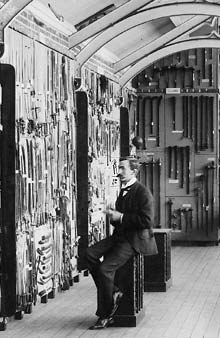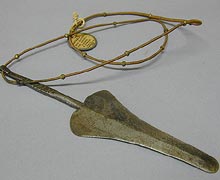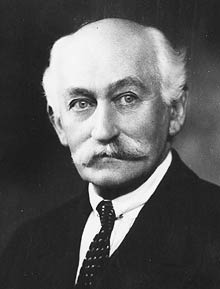Henry Balfour
Henry Balfour was the first curator of the Pitt Rivers Museum. He was born in Croydon in 1863 and started working at the Museum when he was only 22 years old. He devoted the rest of his life to looking after the ethnography collections at Oxford.
As an undergraduate in the early 1880s Balfour studied Natural Sciences at Oxford. When Pitt Rivers' collections were moved to Oxford and the Pitt Rivers Museum was being built to house them in 1885, one of Balfour's tutor's, Henry Nottidge Moseley, asked him to help unpacking and arranging the 'Pitt Rivers Anthropology Collection' at the University Museum. Moseley told him that,
'It would be pretty hard work of all sorts making little drawings, writing and typing out very neat labels, writing catalogue descriptions, arranging things in cases, mending and batching and cleaning, helping a carpenter fix things on screens, looking up objects of all kinds in illustrated books, Cooks travels etc.' (11 October 1885: PRM Manuscript Collections, foundation volume)
Balfour's initial job offer was for one year, but he quickly started negotiating with the University for a more permanent position. By 1889 he was known as the 'Sub-Curator of the Pitt Rivers Museum', and in late 1890 he was appointed Curator, with the same status as the professors working in the University Museum. He held this position until his death, at the age of seventy-five, in 1939.
Balfour worked hard setting up the first displays at the Museum, and was constantly adding material and rearranging the exhibits as new acquisitions poured in from around the world. Over the years he built up a wide circle of colleagues, acquaintances and friends, and was able to draw on a range of relationships to develop the Museum's collections.
He began giving formal lectures to Oxford students in the early 1890s, and by the early 1900s he was giving informal instruction in the Museum to students like Barbara Freire Marecco and Cecil Mallaby Firth. He was one of the founding members of the Committee for Anthropology, which, from 1905, organized the teaching of physical and cultural anthropology at the University. Over the years, Balfour must have taught hundreds of anthropology students. One of them later remembered,
'Our work with Henry Balfour was done entirely in the Pitt-Rivers Museum, of which he was Curator, before exhibition cases which frequently were supplemented with trays or handfuls of additional specimens...The handful of notes which he brought to the peripatetic lecture were suggestive of Darwin's use of every scrap and kind of paper; they were any size and shape, sometimes interspersed with press clippings and portions of letters.' (Wallis 1957: 786-7)

Henry Balfour in the Upper Gallery, probably taken in the early 1890s
(Detail of 1998.267.94.5, copyright PRM)
Many of Balfour's students went on to work abroad as ethnologists and colonial administrators and they sent objects back to the Pitt Rivers Museum from all corners of the globe.
Although he only wrote one book, 'The Evolution of Decorative Art' (1893), Balfour published numerous scholarly articles, often taking a specific type of object - from musical bows to fire-pistons or fishing-kites - and exploring its 'evolutionary development' through history and across different cultures. He frequently finished an article with a request for more information from anyone who had come across similar objects or traditions, and his personal off-prints (now held in the PRM Manuscript Collections) are stuffed with letters and notes sent by interested readers as well as Balfour's own additional notes over the years.
Balfour was a great traveller. He travelled to Norway, Finland and Russian Lapland to study whales and whaling traditions, he visited South Africa four times, as well as Australia, Indonesia, the USA, Canada, India, Brazil, Kenya, Uganda, Nigeria and other East African countries. He always covered a lot of ground wherever he went, and his journeys were often very sociable. At every stop he would meet museum curators, mayors, governors and consuls, collectors, other travellers and a host of local residents.
Through his vast network of friends and acquaintances, and his own frequent travels, he built up an enormous ethnographic and archaeological collection. As a donor, Balfour gave the second highest number of objects to the Museum after General Pitt Rivers: he is recorded as the source for well over 15, 000 objects. He was particularly interested in music and collected many hundreds of musical instruments which form the foundation of the Museum's impressive ethnomusicology collections. He also collected hundreds of stone tools, weapons, objects used to make fire, and lighting technologies, as well as countless other artefacts of all descriptions. He bequeathed his library of several thousand books. However, the fact that he presided over the Museum during the first fifty years of its existence means that the real significance of his work on the collections is beyond measure.

South Africa: Ndebele. Heart shaped iron skin scraper. Donated by Henry Balfour in 1899
(1899.16.11, copyright PRM)
Balfour served as President of the Royal Anthropological Institute, the Museums Association, the Folklore Society and the Royal Geographical Society. He was elected to a fellowship of the Royal Society in 1924, and was given the personal title of Professor of Ethnology by Oxford University in 1935.
Frances Larson
August 2005
Further reading:
Hutton, J.H. 1949 'Balfour, Henry 1863-1939' in Oxford Dictionary of National Biography , Oxford University Press
La Rue, Hélène 2004 'Balfour, Henry (1863-1939)', Oxford Dictionary of National Biography , Oxford University Press
Wallis, Wilson Dallam 1957 'Anthropology in England Early in the Present Century' in American Anthropologist vol. 59, No. 5, pp. 781-790


